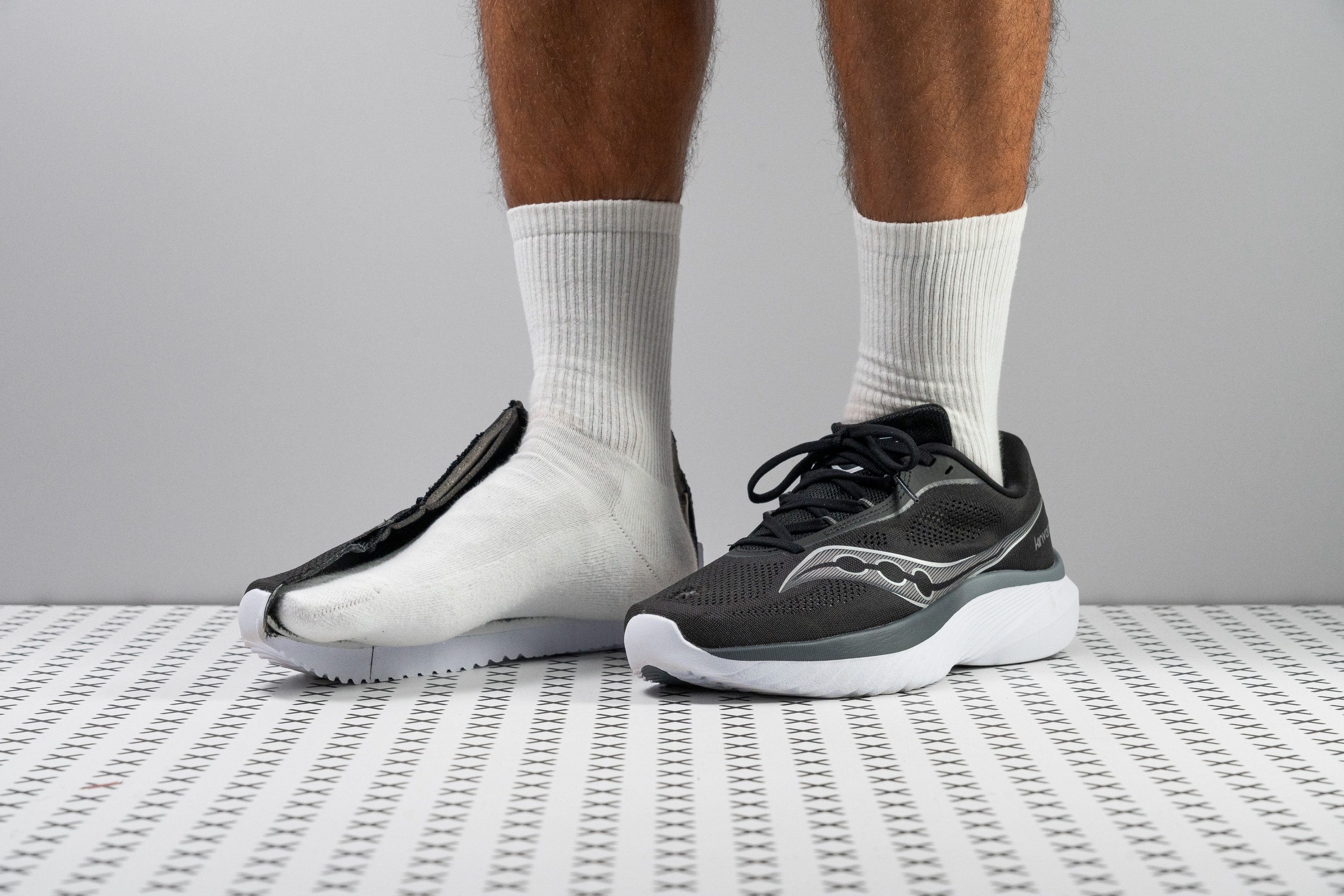Nuestra conclusión
Pros
- Baratas
- Ideales para ritmos rápidos
- Con rebote
- Con las vibras clásicas de Kinvara
- Pisada estable y cercana al suelo
- Adecuadas para el uso diario
- Muy ligeras
- Hacen que los pies tengan más fuerza
- Increíblemente transpirables
Contras
- Solo para distancias cortas
- No son ideales para los talonadores
- Durabilidad de la parte delantera
- La suela exterior casi no tiene protección de caucho
Veredicto de los usuarios
Comparativa
Las zapatillas de running más parecidas
+ + Añadir unas zapatillas | |||||
|---|---|---|---|---|---|
| Puntuación global | 84 Buenas | 88 Notables | N/A | 87 Notables | |
| Precio | 145 € | 140 € | 140 € | 110 € | |
| Pace | Correr a diarioTempo / series | CompeticiónTempo / series | Correr a diarioTempo / series | Correr a diario | |
| Absorción de impactos | Moderada | - | Baja | - | |
| Retorno de energía | Moderado | - | Bajo | - | |
| Tracción | Moderada | - | Alta | - | |
| Arch support | Neutral | Neutral | Neutral | Neutral | |
| Peso laboratorio Peso marca | 6.8 oz / 194g 6.7 oz / 190g | 7.9 oz / 224g 7.9 oz / 224g | 7.3 oz / 207g 7 oz / 198g | 9 oz / 254g 9.4 oz / 266g | |
| Lightweight | ✓ | ✓ | ✓ | ✗ | |
| Drop laboratorio Drop marca | 4.4 mm 4.0 mm | 1.1 mm 0.0 mm | 4.5 mm 4.0 mm | 6.0 mm 8.0 mm | |
| Técnica de carrera | Medio/antepié | Medio/antepié | Medio/antepié | Medio/antepié | |
| Talla | Tallan un poquito pequeño | Tallan bien | - | Tallan bien | |
| Rigidez de la mediasuela | Equilibrada | Equilibrada | Equilibrada | Equilibrada | |
| Diferencia de la rigidez de la mediasuela en frío | Pequeña | Normal | Pequeña | Pequeña | |
| Durabilidad de la parte delantera | Mala | Buena | Mala | Mala | |
| Durabilidad del acolchado del talón | Alta | Media | Alta | Media | |
| Durabilidad de la suela exterior | Buena | Buena | Mala | Buena | |
| Transpirabilidad | Alta | Alta | Alta | Baja | |
| Anchura / ajuste | Media | Ancha | Media | Media | |
| Anchura de la parte delantera | Media | Ancha | Estrecha | Media | |
| Flexibilidad | Flexible | Moderada | Moderada | Rígida | |
| Rigidez torsional | Flexibles | Flexibles | Moderadas | Flexibles | |
| Rigidez del contrafuerte del talón | Flexible | Flexible | Moderado | Flexible | |
| Talón laboratorio Talón marca | 27.9 mm 30.0 mm | 22.5 mm 24.0 mm | 28.0 mm 29.0 mm | 30.2 mm 27.0 mm | |
| Antepié laboratorio Antepié marca | 23.5 mm 26.0 mm | 21.4 mm 24.0 mm | 23.5 mm 25.0 mm | 24.2 mm 19.0 mm | |
| Anchuras disponibles | EstándarAncho | Estándar | Estándar | Estándar | |
| Orthotic friendly | ✓ | ✓ | ✓ | ✓ | |
| Estación | VeranoTodas las estaciones | VeranoTodas las estaciones | VeranoTodas las estaciones | Todas las estaciones | |
| Removable insole | ✓ | ✓ | ✓ | ✓ | |
| Clasificación | #472 29% inferior | #139 Top 37% | #349 7% inferior | #171 Top 46% | |
| Popularidad | #295 Top 45% | #251 33% inferior | #179 Top 48% | #312 17% inferior |
Quién debería comprárselas
Las Kinvara 15 destacan como un soplo de aire fresco en un mundo dominado por los pares maximalistas. Aquí, en el laboratorio, creemos que son:
- Una excelente elección para los que están empezando con las zapatillas de running con un drop y una suela bajos.
- Perfectas para los fans de la serie Kinvara, ya que ofrecen esa sensación familiar con mejoras sutiles en todo.
- Una opción ideal para los corredores que buscan fortalecer sus pies sin tener que tirarse a la piscina con unas zapatillas con drop cero o ultraminimalistas, ¡y todo a un precio que probablemente te guste!

Quién NO debería comprárselas
Aunque las Kinvara 15 tienen un diseño increíblemente ligero, no te las podemos recomendar si la durabilidad de la suela exterior es un punto clave para ti. Al tener tan poquito caucho protegiéndola, el desgaste es más rápido, sobre todo para los sobrepronadores o la gente que corre por caminos de grava. Si estás buscando unas zapatillas ligeras que tengan más caucho en la suela exterior, te recomendamos las Nike Streakfly o las Adidas Adios 8.
Además, creemos que las Kinvara 15 se quedan cortas en cuanto a retorno de energía. Los corredores que busquen una mayor reactividad podrían preferir las alternativas mencionadas anteriormente. Además, las ligerísimas Saucony Sinister tienen un diseño parecido, también con una suela baja, pero cuentan con la espuma PWRRUN PB, que es de primera y ofrece un mejor rendimiento.
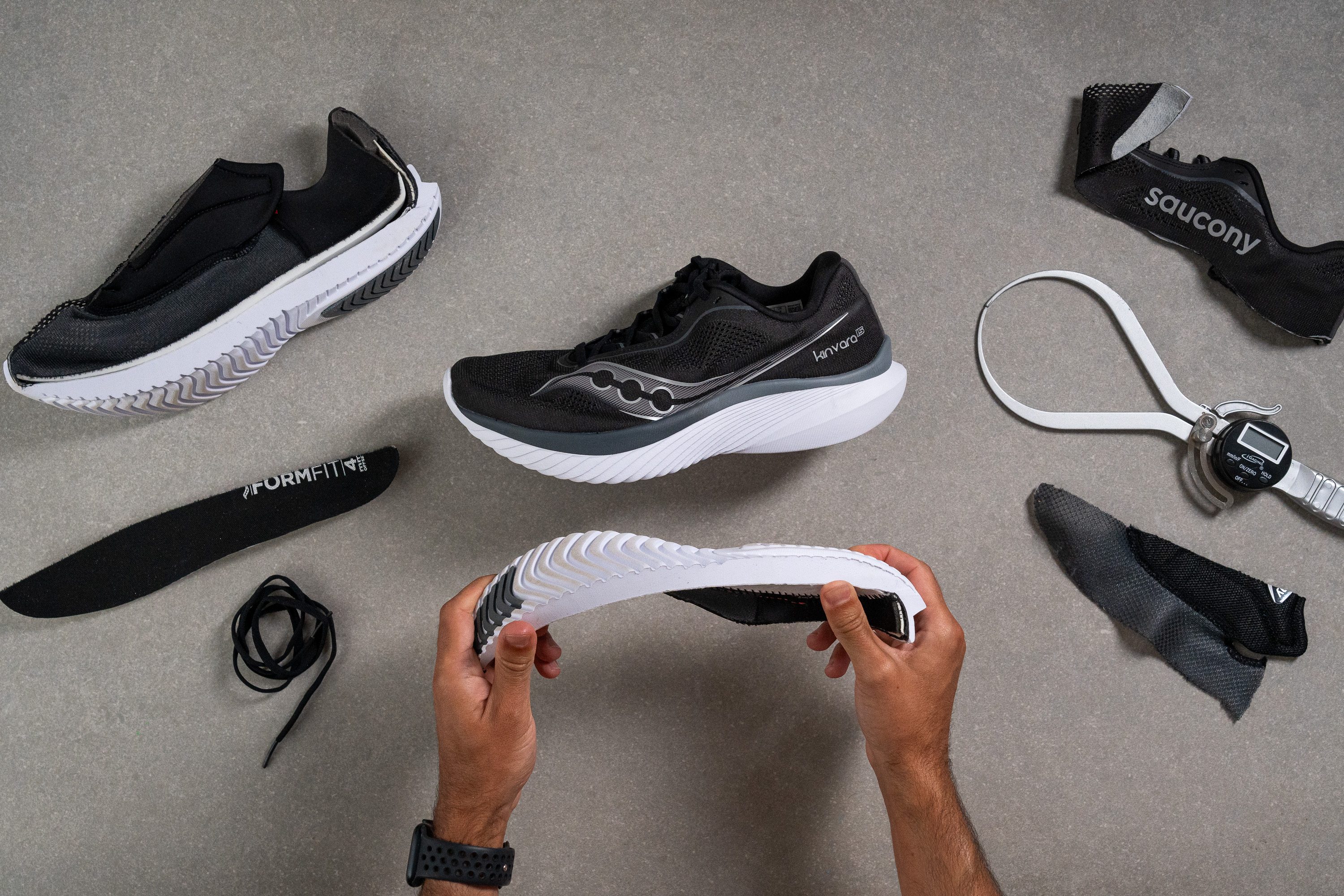
Amortiguación
Shock absorption
Algunos corredores sintieron que la versión anterior de las Kinvara no ofrecía el contacto con el suelo de los modelos anteriores. Probablemente por eso Saucony redujo la amortiguación en esta actualización, y ahora se ha llevado un resultado de 117 SA en el talón y 107 SA en el antepié.
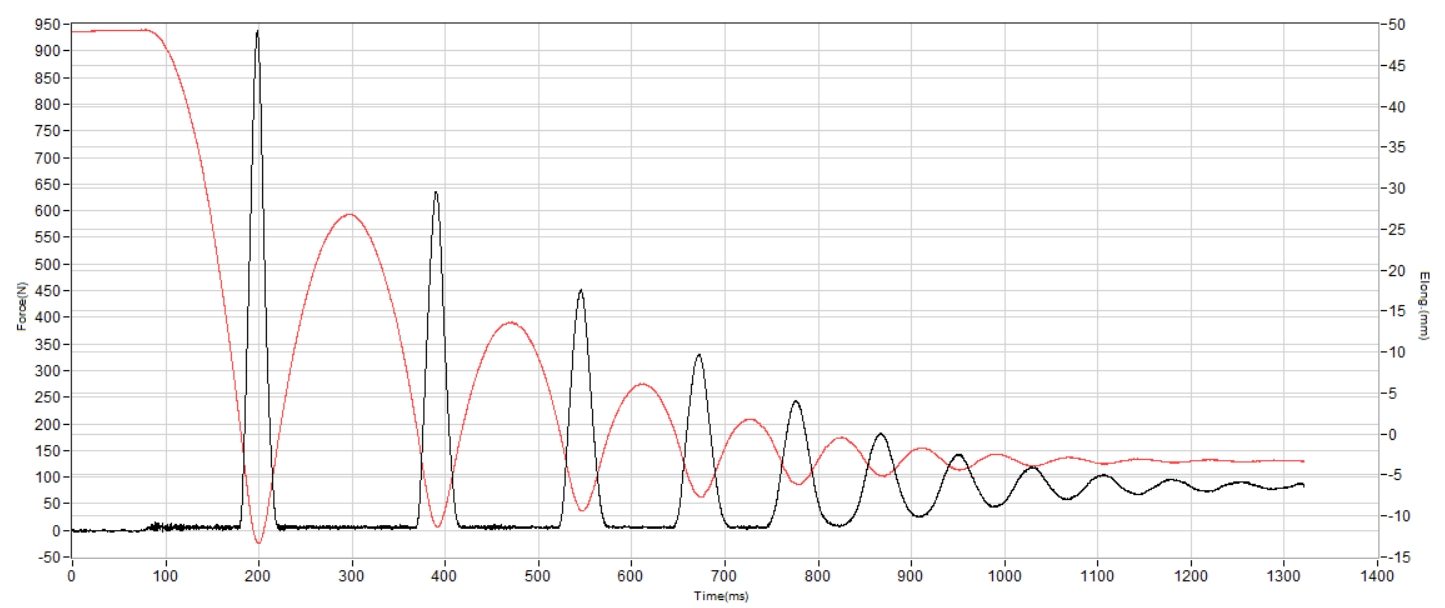
| Kinvara 15 | 117 SA |
| Media | 129 SA |
Energy return
La mediasuela es prácticamente igual y ofrece un rebote moderado del 57,2 % en el talón y del 60,8 % en la parte delantera. Teniendo en cuenta el rango de precios por el que se mueven las Kinvara, la verdad es que dudamos que ofrezcan mucho más en un futuro.
| Kinvara 15 | 57.2% |
| Media | 58.5% |
Altura de la suela en la zona del talón
Saucony afirma que las Kinvara tienen una suela de 30/26 mm, pero las mediciones que hicimos en nuestro laboratorio no terminan de estar de acuerdo.
El talón mide 27,9 mm, 2,1 mm menos de lo esperado. Esto podría ser una ventaja para los corredores que está buscando una pisada que ofrezca más contacto con el suelo. Así que mira, como se suele decir, ¡hay que ver el vaso medio lleno!
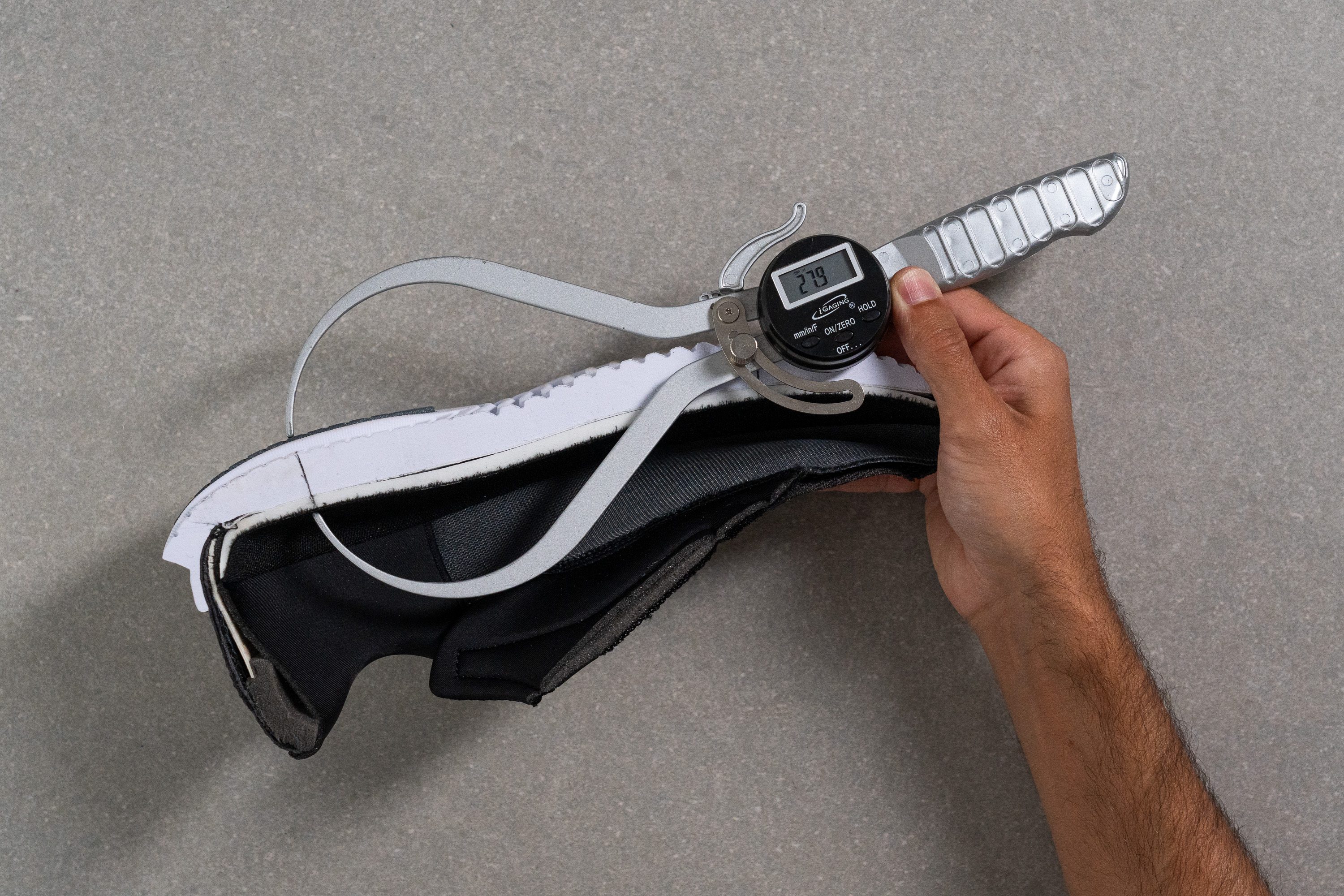
| Kinvara 15 | 27.9 mm |
| Media | 34.8 mm |
Altura de la suela en el antepié
De la mano con lo anterior, el antepié también mide menos de los 26 mm declarados por la marca, llegando solo a los 23,5 mm. Aunque es una cifra distinta de la que da Saucony, casi ni se nota, y es muy poco probable que a la mayoría de los corredores les afecte. La verdad es que nos sorprendería que alguien pudiera notar una diferencia tan sutil en la amortiguación.
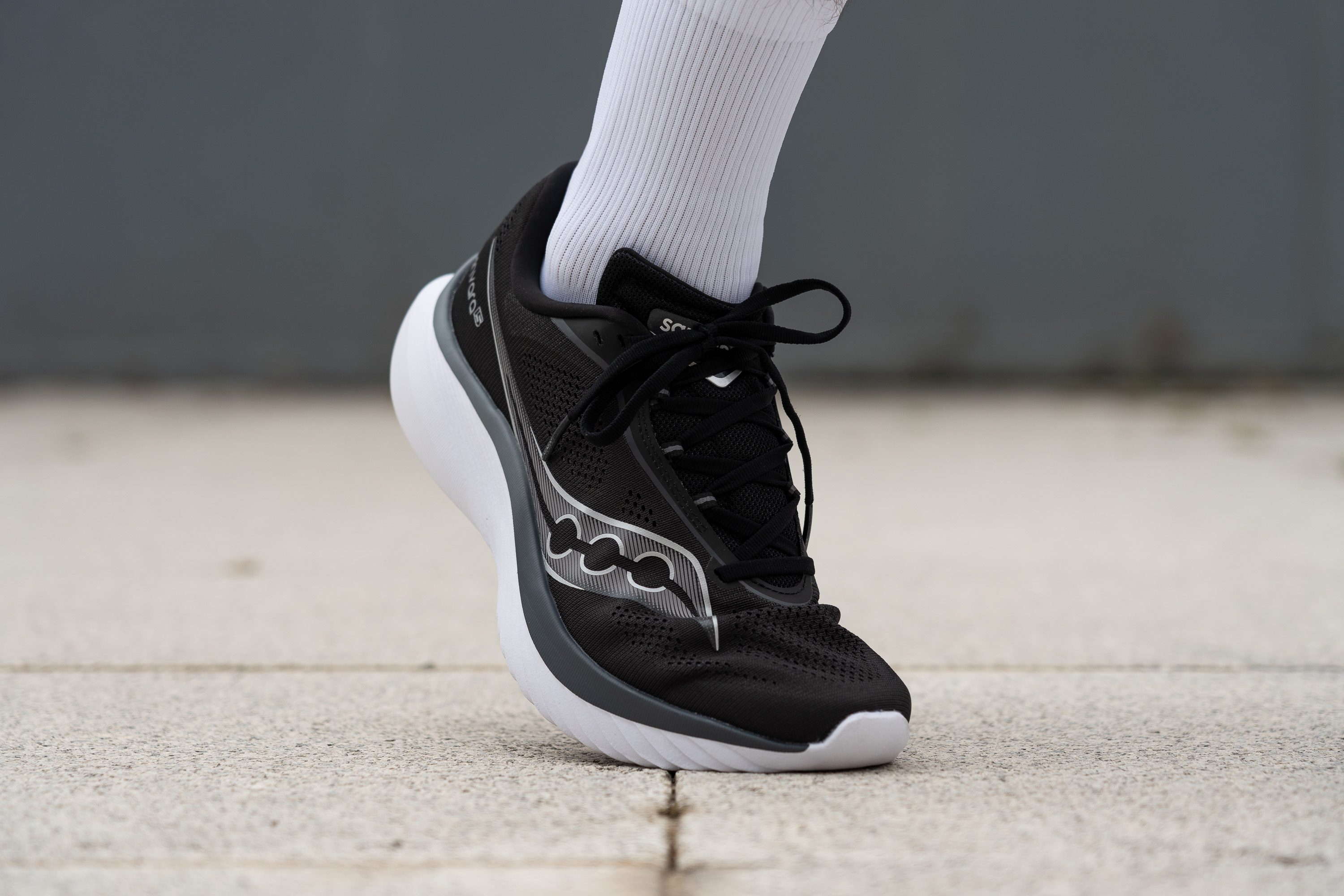
Esta medida corrobora un hecho conocido entre los amantes de las Kinvara: estas zapatillas no están diseñadas ni para las carreras de larga distancia ni para los corredores más pesados, lo que tiene sus ventajas e inconvenientes.
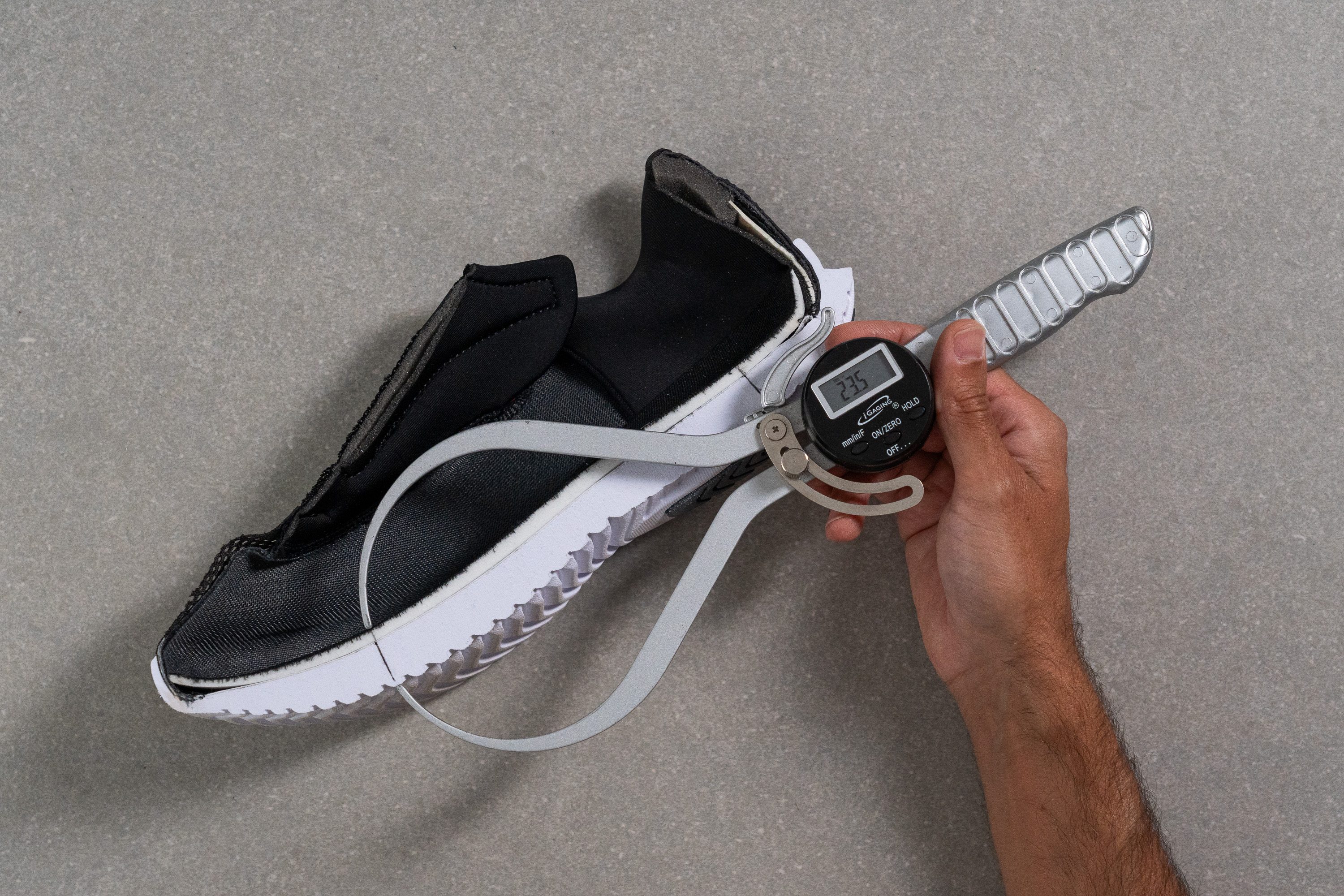
| Kinvara 15 | 23.5 mm |
| Media | 26.2 mm |
Drop
Otro rasgo característico de las Kinvara DNA es el drop bajo de su diseño, y lo hemos comprobado en nuestro laboratorio. Nos dio 4,4 mm, coincidiendo así con los 4 mm de los que habla la marca.
Este drop es ideal para los corredores de mediopié y de metatarsos, que pueden beneficiarse plenamente de este diseño. Así que, aunque las Kinvara les pueden ir bien a los talonadores, no creemos que sean las más adecuadas para ellos, ya que tienen un drop bajo y un perfil plano, sin rocker. En su lugar, a ellos les recomendamos las Nike Free RN NN.
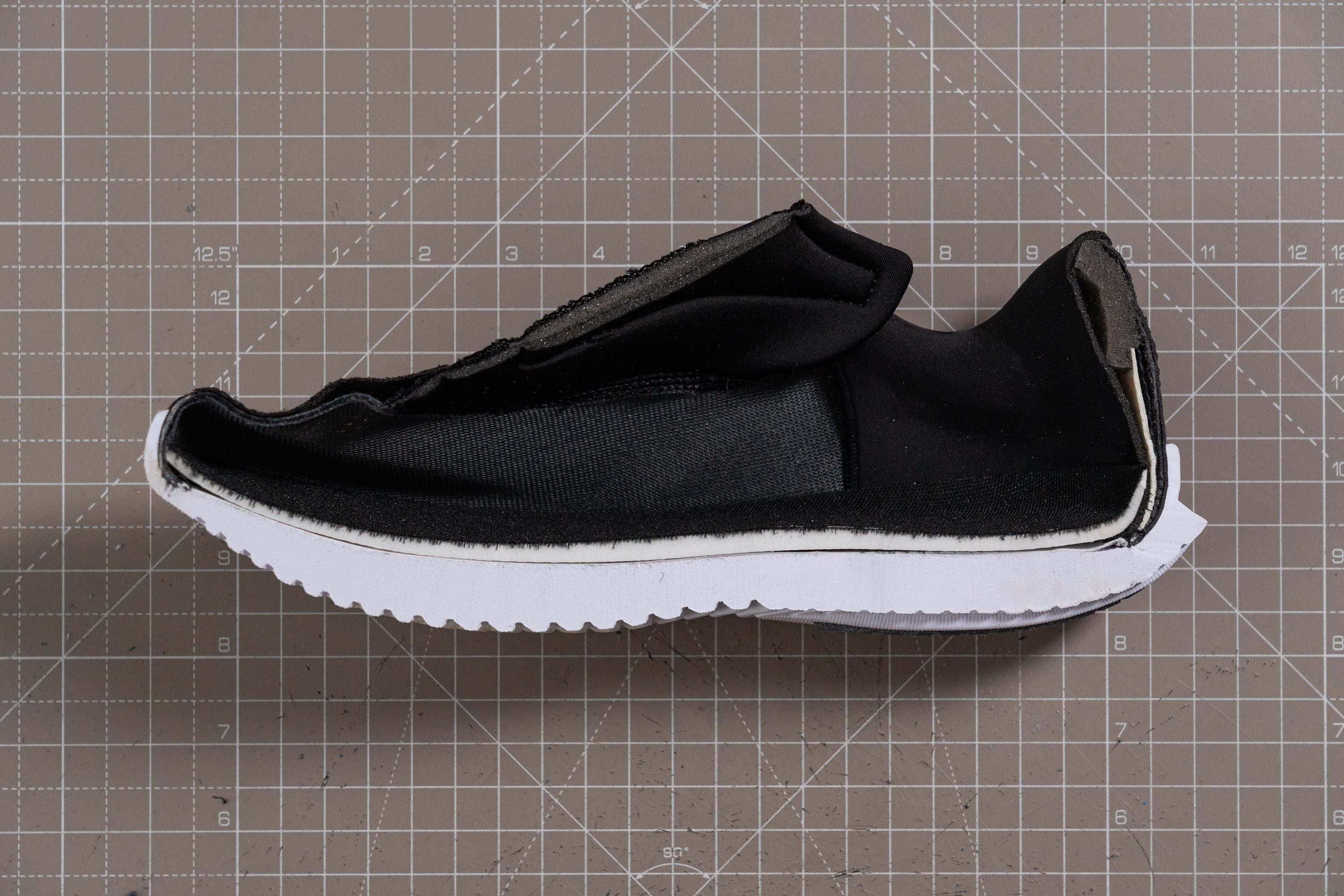
| Kinvara 15 | 4.4 mm |
| Media | 8.6 mm |
Suavidad de la mediasuela
Vale, ahora nos vamos a centrar en la mediasuela PWRRUN. Sí, Saucony sigue pasado de utilizar su espuma PWRRUN PB basada en Pebax (que es más blanda) para esta línea, y nos parece comprensible, ya que es difícil mantener el rango de precios actual de las Kinvara utilizando un material tan premium.
A ver, entonces, ¿por qué la marca escogió utilizar la espuma PWRRUN en lugar de la PWRRUN+? Pues la respuesta está en el peso. La PWRRUN+ es bastante más reactiva, pero también es bastante más pesada, porque está hecha completamente de TPU. Por otro lado, la mediasuela PWRRUN es una mezcla de EVA y TPU, lo que la hace más ligera.

Con un resultado de 23,8 HA en nuestro durómetro, descubrimos que la pisada es más firme, lo que probablemente sea una decisión acertada para una mediasuela tan fina, evitando así correr el riesgo de chafarla totalmente en cada paso.
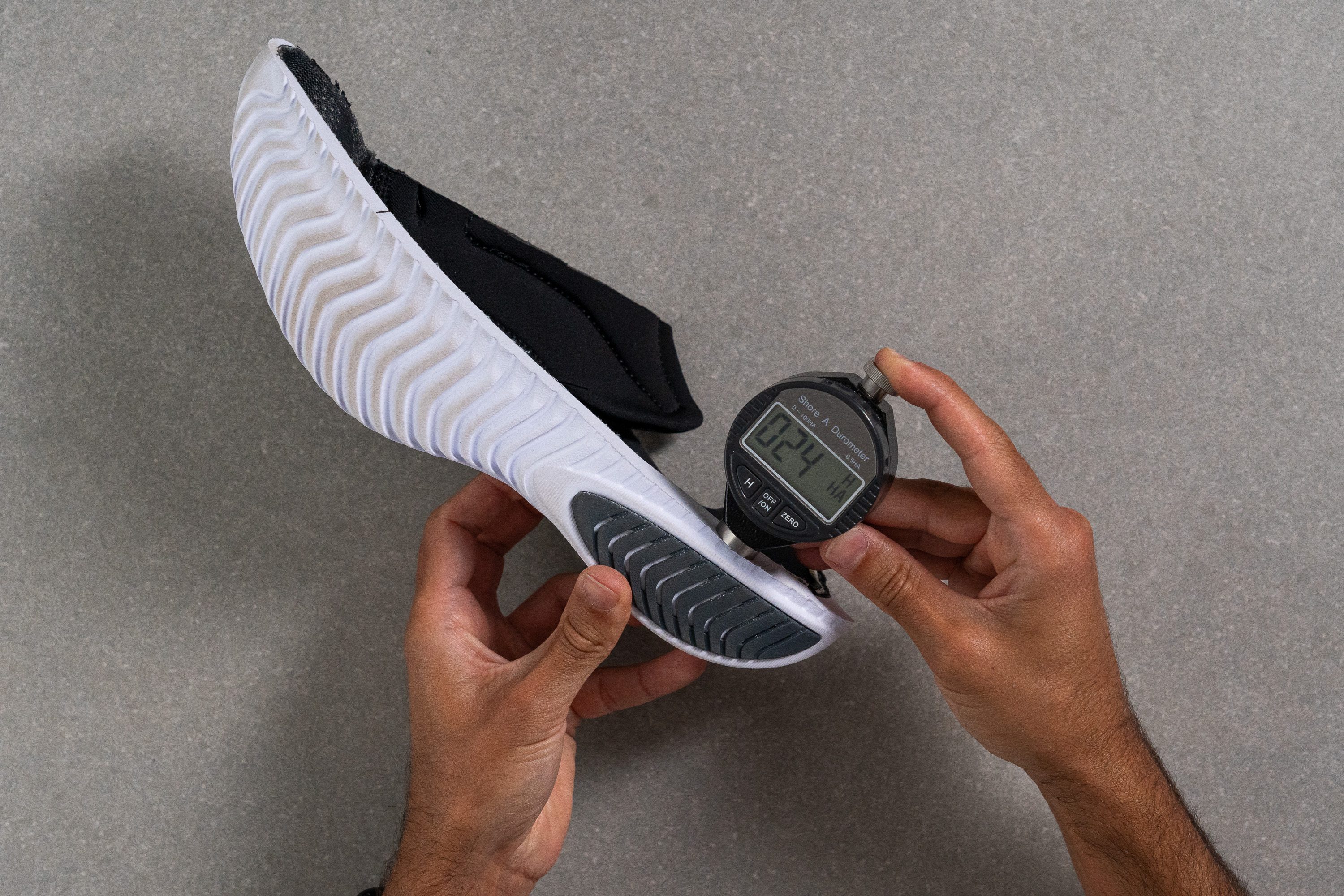
| Kinvara 15 | 23.8 HA |
| Media | 20.4 HA |
Rocker
Aunque hay muchas zapatillas que se han subido a la ola del rocker, y algunos incluso la han surfeado, Saucony ha decidido mantener a las Kinvara fieles a sus orígenes. Esto significa tener una mediasuela plana y sin rocker, que es algo que nos encanta.
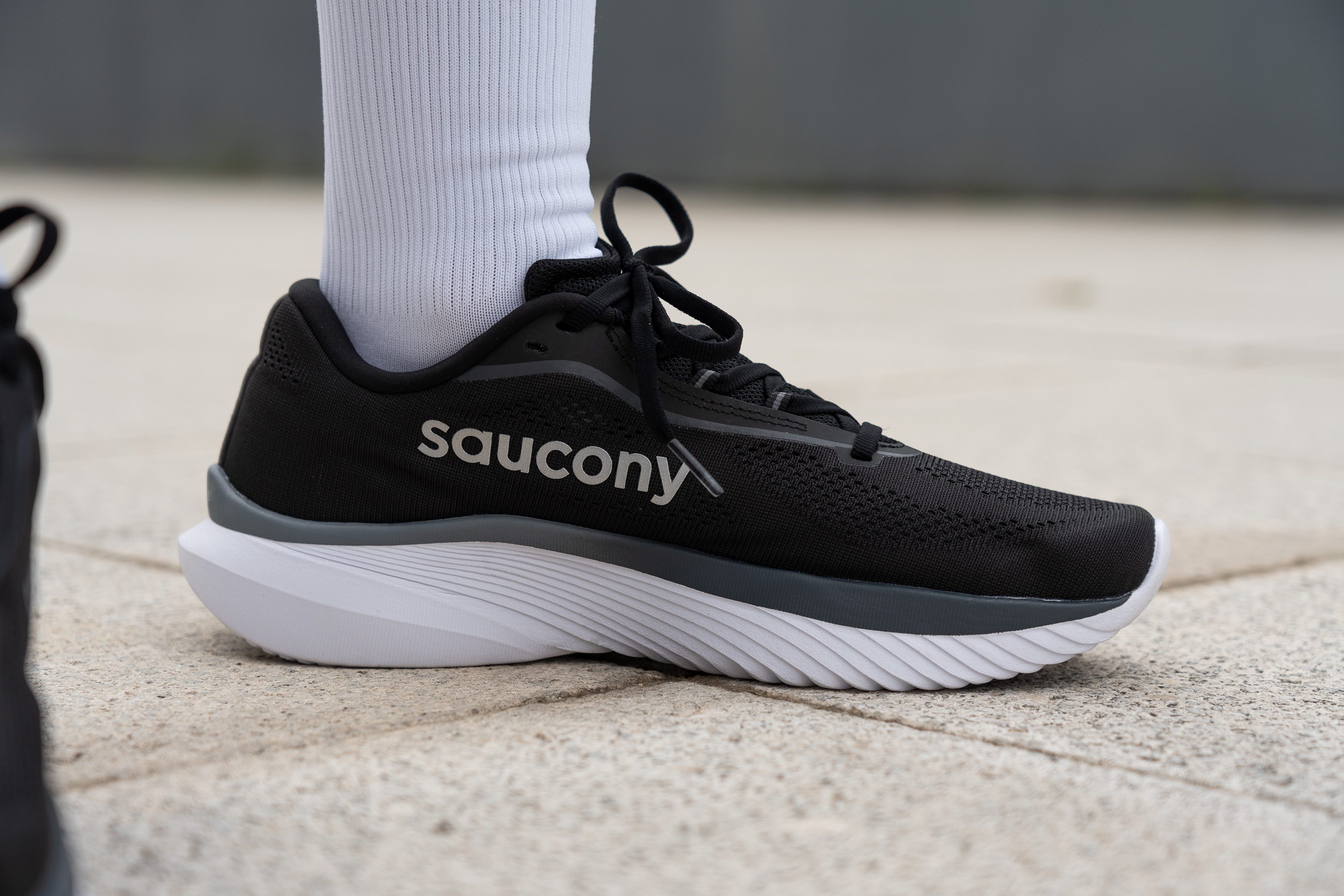
Con una mediasuela de menos de 30 mm tanto en el antepié como en el talón y sin placa que restrinja la flexibilidad, no es necesario que la parte delantera sea como un muelle. Por lo tanto, las Kinvara ofrecen una pisada natural que nos ha parecido ideal para fortalecer el pie, lo que las convierte en una opción interesante en el mercado actual.
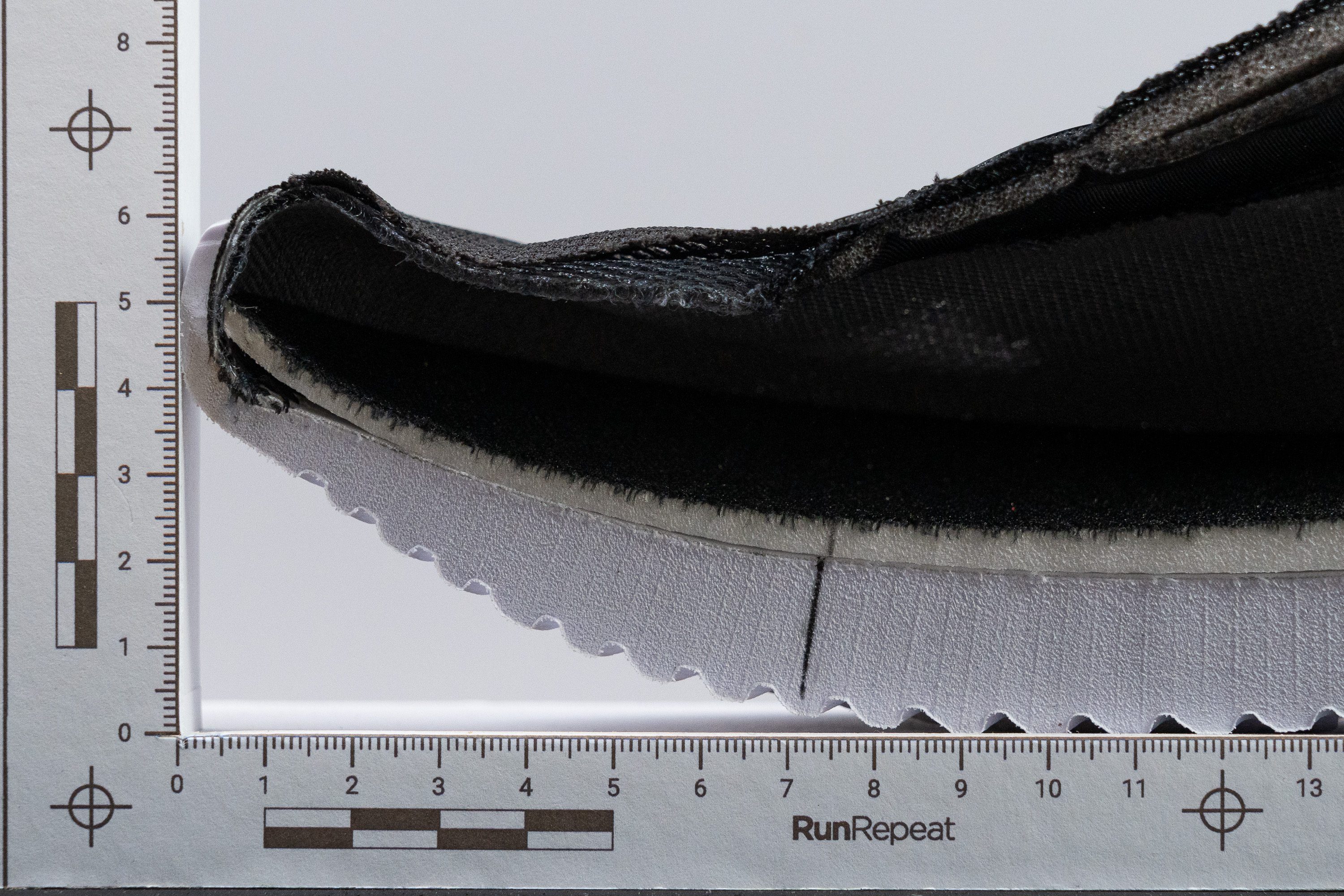
Tallaje y ajuste
Talla
Las Saucony Kinvara 15 quedan un poco pequeñas (47 votos).
Longitud interna
| Kinvara 15 | 268.0 mm |
| Media | 269.5 mm |
Anchura / Ajuste
La zona más ancha de las Kinvara 15 mide exactamente 96,2 mm, que es un resultado que está dentro de la media.
Y así es justo como se sienten las zapatillas: totalmente estándar. Nos las pusimos para correr tanto distancias cortas como medias, y nos ofrecieron un ajuste seguro y con una buena sujeción.
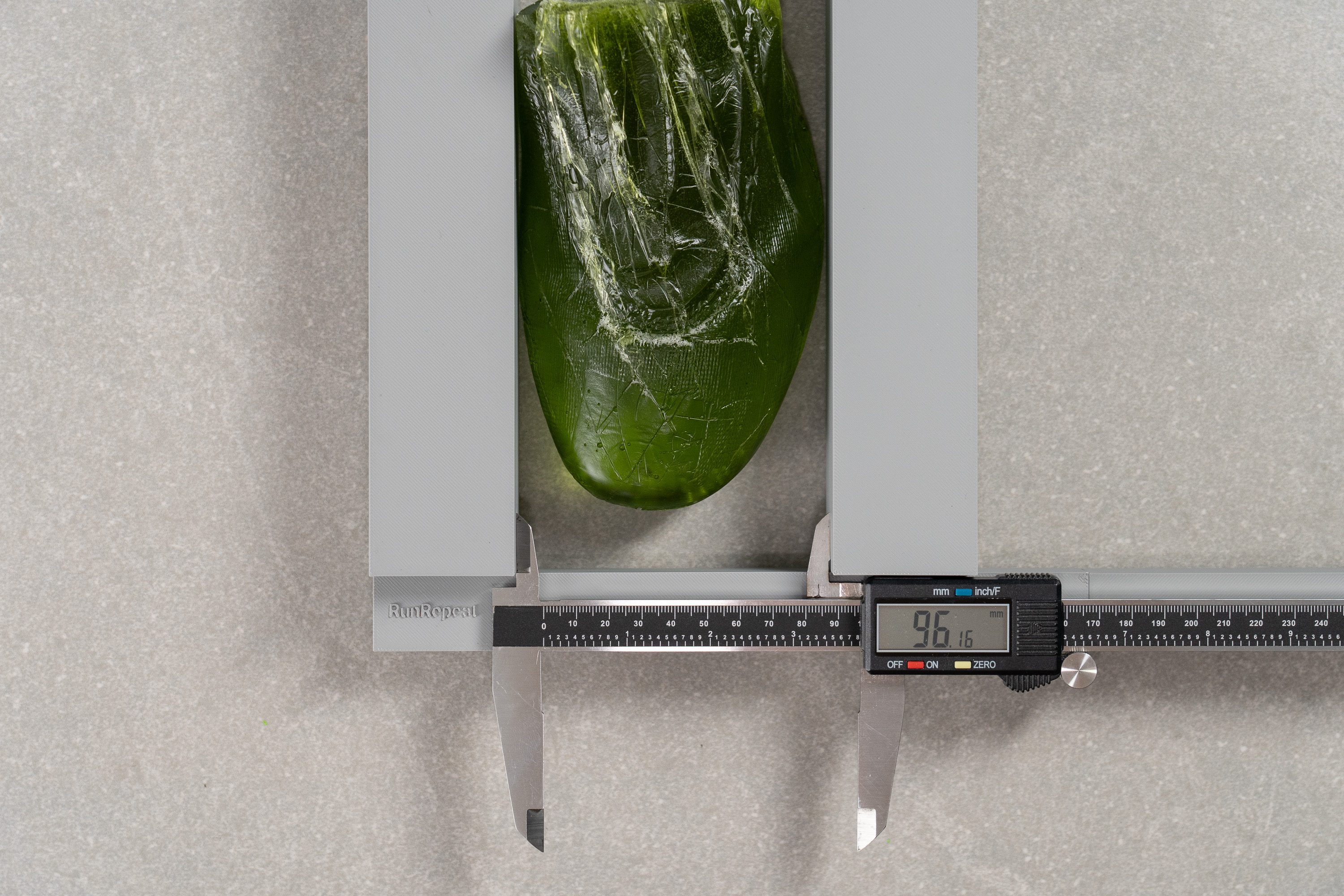
| Kinvara 15 | 96.2 mm |
| Media | 95.1 mm |
Anchura de la parte delantera
Con una anchura de 71,2 mm en la zona del dedo gordo, nuestra sugerencia es que no te esperes un amplio espacio para mover los dedos de los pies, porque... no va a pasar.

De hecho, si lo que estás buscando es una parte delantera espaciosa en un diseño minimalista y con drop bajo, creemos que lo mejor es que les eches un ojo a las Altra Escalante Racer 2.

| Kinvara 15 | 71.2 mm |
| Media | 73.3 mm |
Altura de la parte delantera
El volumen vertical de la parte delantera nos dio 31,4 mm, superando así al que ofrecen la mayoría de las zapatillas de running.
Pero claro, aunque este diseño tan generoso les puede encantar a las personas que están buscando un ajuste cómodo, probablemente no termine de convencer a los corredores que prefieren un ajuste más ceñido para correr a ritmos más rápidos.
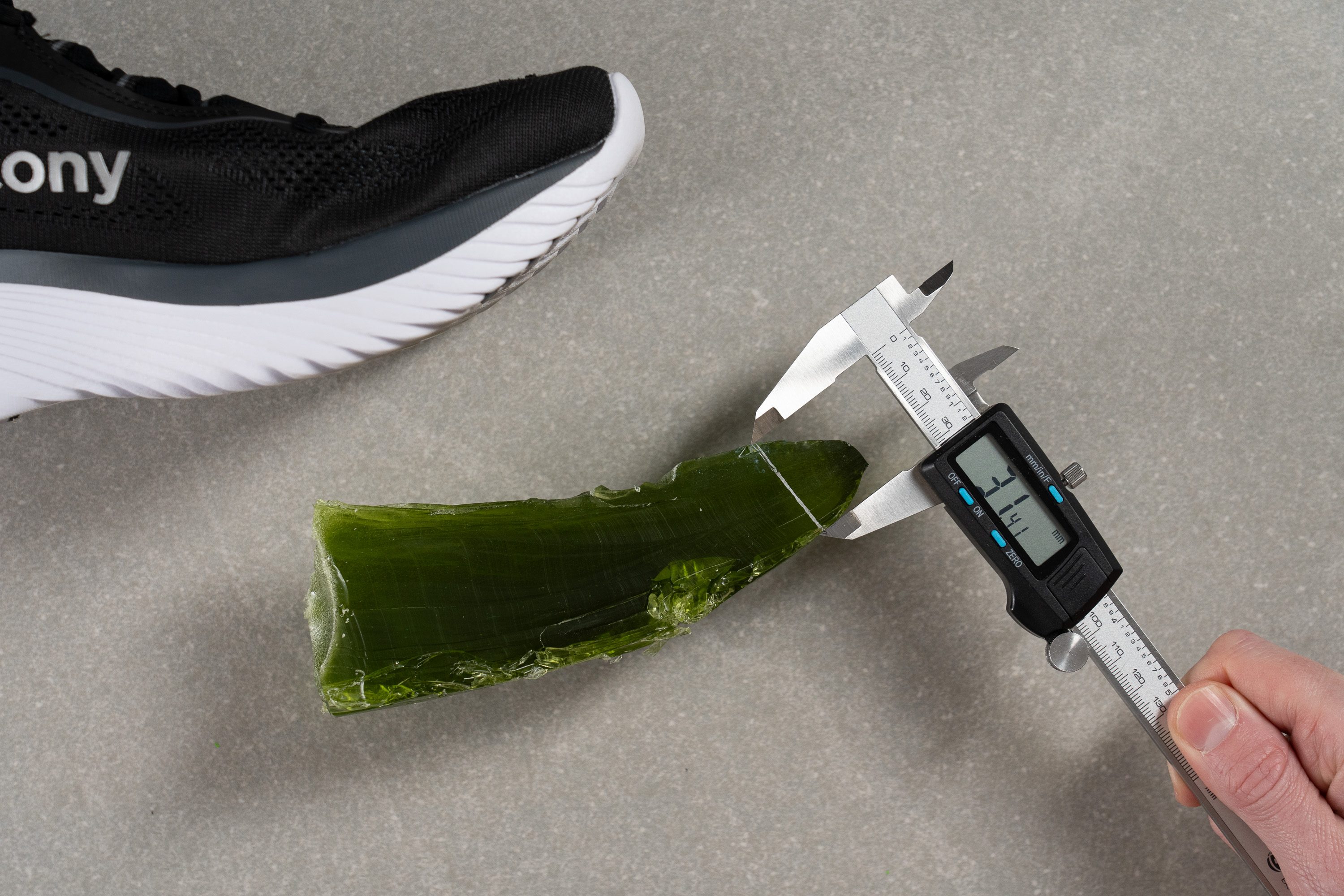
| Kinvara 15 | 31.4 mm |
| Media | 27.1 mm |
Tracción / Agarre
Traction test
Las Saucony Kinvara 15 se llevaron un 0,41 en esta prueba, así que su rendimiento es sólido haga el tiempo que haga. La verdad es que es un resultado impresionante teniendo en cuenta toda la espuma expuesta que tienen en la suela en comparación con otros modelos de entrenamiento ligeros.
| Kinvara 15 | 0.41 |
| Media | 0.48 |
Diseño de la suela exterior
Con solo echarle un vistazo a la suela exterior, ya nos quedó claro que Saucony se centra en reducir el peso, ya que en la mayor parte hay espuma expuesta. Quitando un par de vainas de caucho (una en el lateral del talón y otra en la cara interna del antepié), toda la suela exterior está hecha de EVA reforzada.
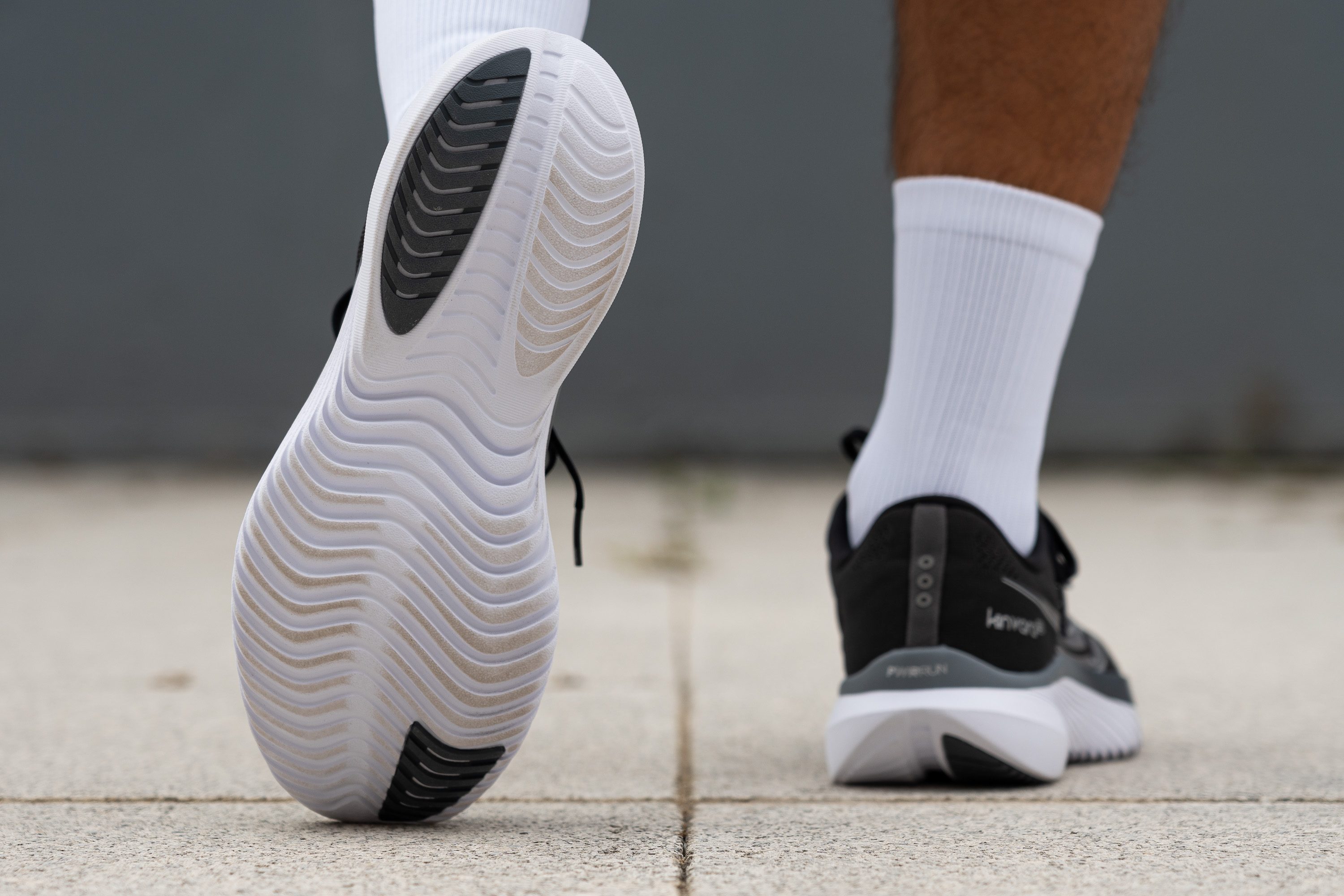
Flexibilidad / Rigidez
Las Kinvara 15 no tienen placa, su suela es bajita, y tienen una suela exterior que casi no tiene caucho pero que está llena de cortes. Básicamente, estas zapatillas están diseñadas para tener una flexibilidad longitudinal de primera, así que nos pusimos manos a la obra para comprobarlo.
Empezamos por fijarlas a una mesa, y luego las doblamos 30 grados con nuestra máquina. La verdad es que no nos costó nada, ya que solo necesitamos 91, N para conseguirlo. Esto no solo destaca su maravillosa flexibilidad, sino que también nos deja claro que son lo suficientemente cómodas para el uso diario.
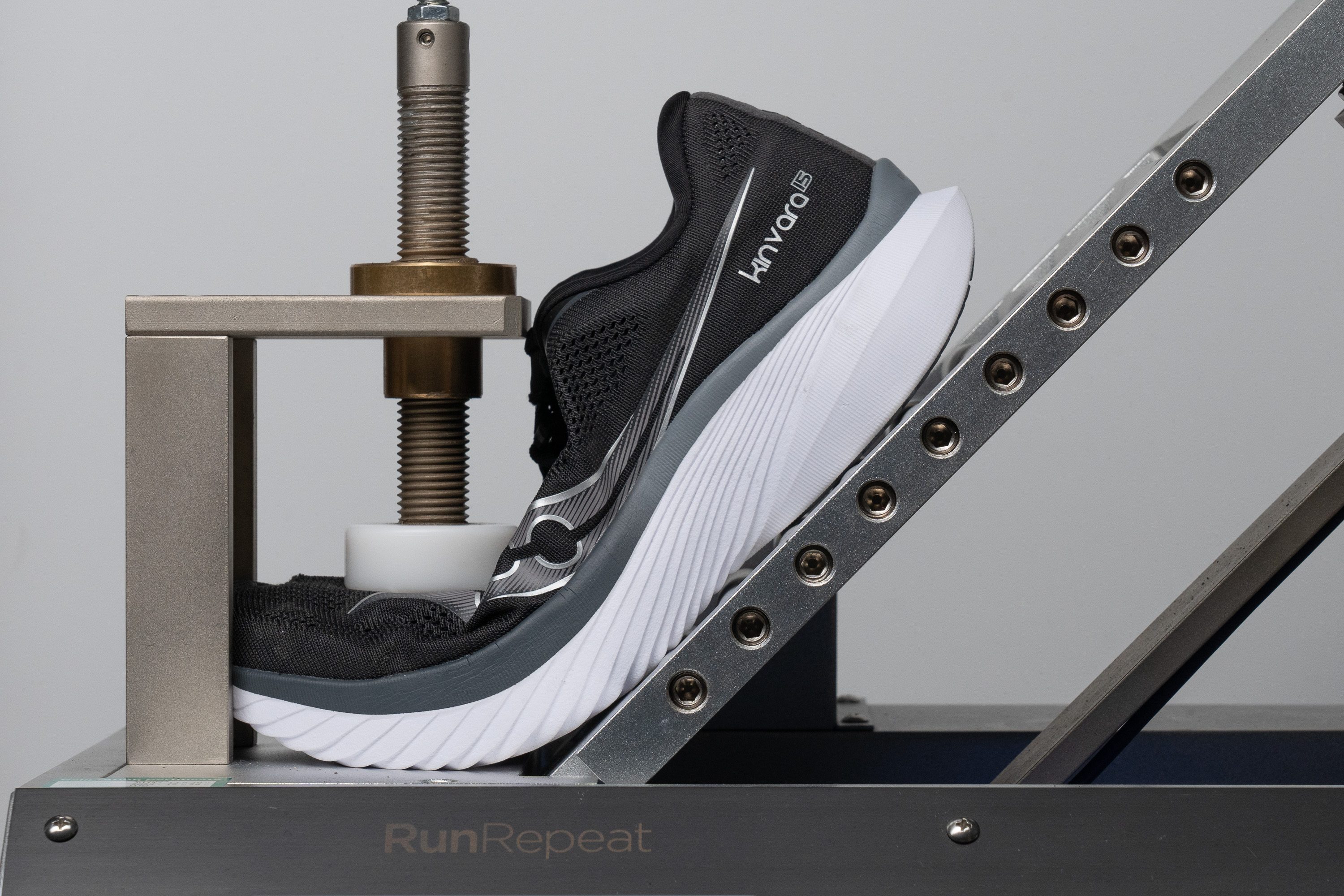
| Kinvara 15 | 9.1N |
| Media | 15.3N |
Rigidez en frío (%)
Repetimos nuestra prueba en el congelador, pero el rendimiento de estas zapatillas no supo a poco. Esta vez, la rigidez aumentó un 39,3 %, un cambio que sin duda se notaría y sería perjudicial a bajas temperaturas.
| Kinvara 15 | 39% |
| Media | 33% |
Peso
Si tuviéramos que resumir las Kinvara 15 en solo una palabra, diríamos "ligereza", no tenemos ninguna duda. Esto fue lo primero que sentimos cuando las sacamos de la caja, y lo confirmaron nuestras primeras pruebas. Después comprobamos su peso en nuestra báscula, ya que no podíamos esperar a ver si estaban a la altura de nuestras expectativas.
Fieles a su legado, las ligerísimas Kinvara 15 solo pesan 194 g, igual que sus predecesoras. Así que sí, ¡su ADN sigue intacto!
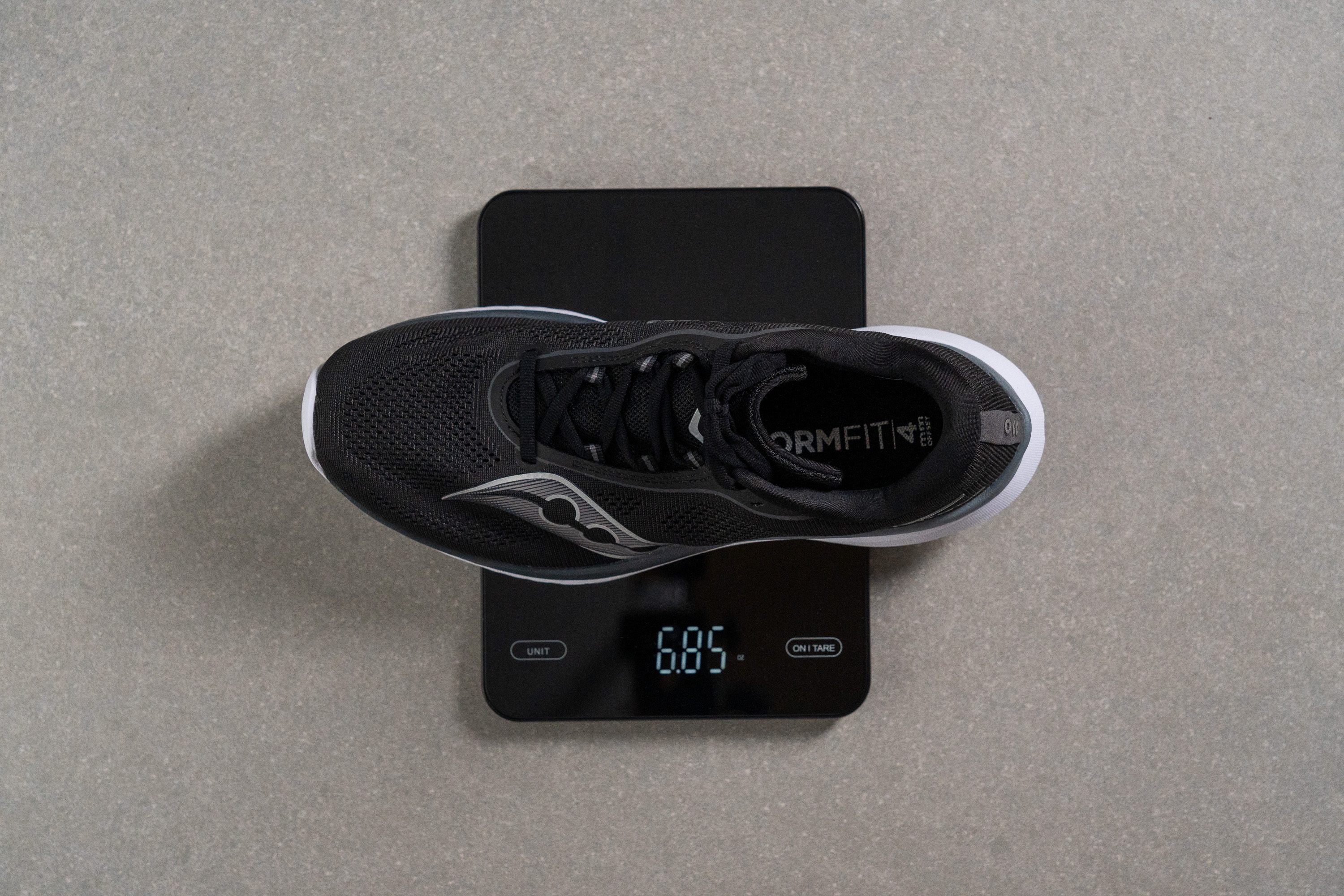
| Kinvara 15 | 6.8 oz (194g) |
| Media | 9.3 oz (264g) |
Transpirabilidad
Nada más sacar las Kinvara 15 de la caja, nos dimos cuenta de que la parte superior de malla de ingeniería estaba llena de agujeritos por toda la parte delantera y el mediopié, lo que sugiere una excelente transpirabilidad. Para comprobarlo, pusimos en marcha nuestra máquina de humo y vimos que estas zapatillas no tenían problema en dejarlo salir, así que les dimos un 5/5 en transpirabilidad.
Utilizamos nuestra luz para ver bien todos esos agujeritos, y nos quedamos encantados al descubrir que este modelo tienen un montón no solo en la parte delantera, que es donde casi todas las zapatillas presumen de una buena transpirabilidad, sino también a lo largo de los laterales, lo que indica que las Kinvara van más allá de la media.
También examinamos la malla de ingeniería bajo nuestro microscopio y, como era de esperar, no nos encontramos con nada especial. Básicamente, estas zapatillas tienen una parte superior de malla sencilla y rentable que rinde muy bien en climas cálidos.
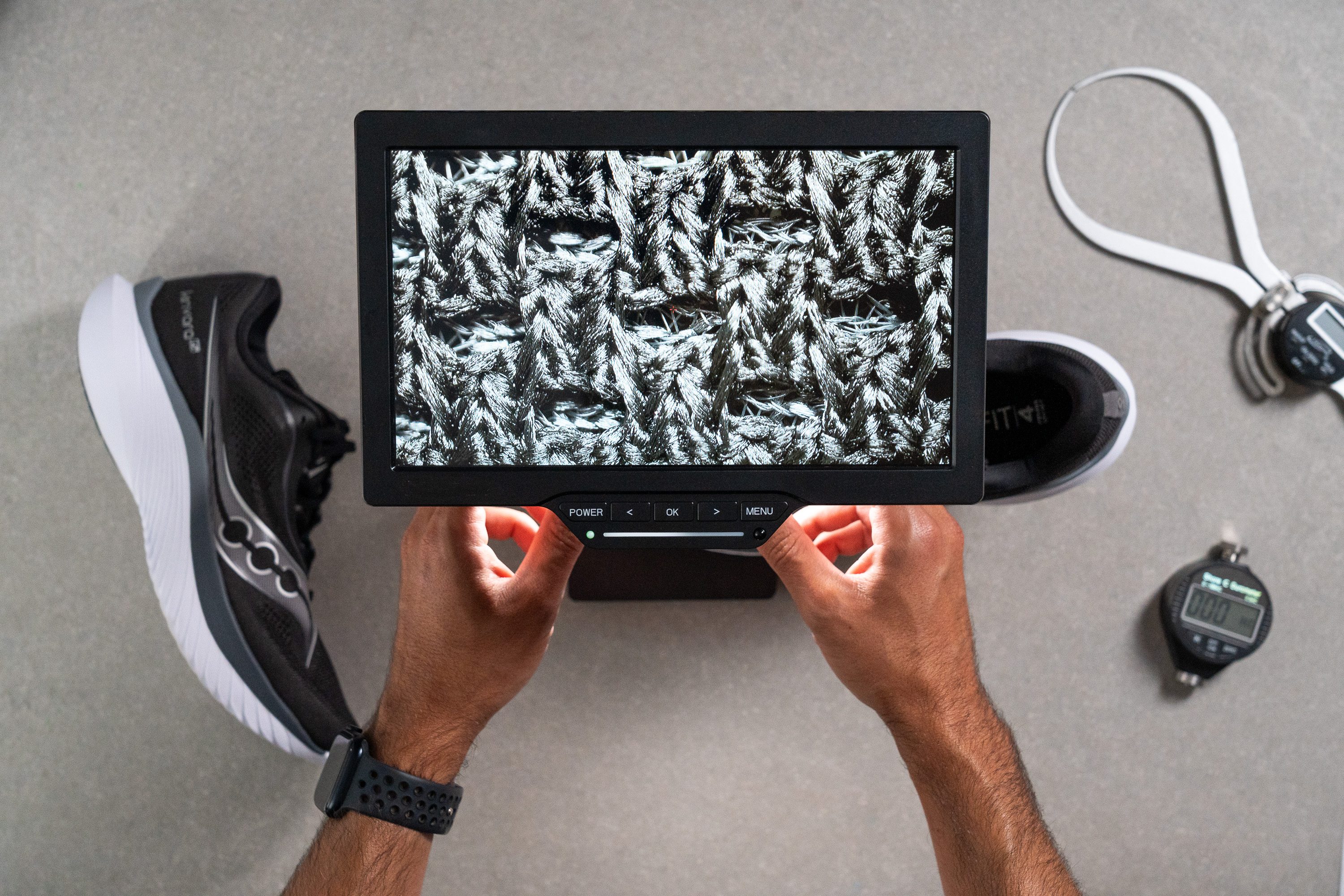
También nos hemos dado cuenta de que Saucony ha optado por una estructura poco común, con una capa más fina en el exterior y una tela mullida en el interior, invirtiendo el diseño más habitual.
Otro detalle que nos ha llamado la atención es que están bastante acolchadas incluso siendo tan ligeras, además de que tienen un contrafuerte interno hecho con cartón blanco.
| Kinvara 15 | 5 |
| Media | 3.7 |
Estabilidad
Prueba de estabilidad lateral
Puede que las Kinvara 15 no te parezca especialmente estables a primera vista, pero podrían sorprenderte con su rendimiento.
Cuentan con una mediasuela moderadamente firme, una suela baja y paredes laterales, lo que las hace adecuadas para los corredores con necesidades leves de estabilidad, sobre todo para los que impactan con el mediopié o los metatarsos.
Rigidez torsional
Las Kinvara se inclinan hacia el minimalismo, así que nos esperábamos que fuesen más bien flexibles. Pudimos confirmarlo en nuestro laboratorio, y decidimos darles un 2/5 en flexibilidad. Como se puede ver en el vídeo, doblarlas no cuesta nada, aunque son un poco más rígidas que la versión anterior.
| Kinvara 15 | 2 |
| Media | 3.5 |
Rigidez del contrafuerte del talón
El contrafuerte del talón de las Kinvara 15 incluye una pieza interna de cartón para darle más estructura, pero es bastante bajo y tampoco es muy rígido. Por lo tanto, le hemos dado un 2/5 en esta prueba. Este resultado encaja con el ADN de las Kinvara, ya que son más flexibles que la media de las zapatillas de running, aunque no alcancen los niveles más altos.
| Kinvara 15 | 2 |
| Media | 2.9 |
Anchura de la mediasuela - antepié
Descubrimos un leve aumento de 1,7 mm en la anchura de las Kinvara 15 en comparación con sus predecesoras, un cambio casi imperceptible.

Y lo que es más importante, con 113,0 mm, estas zapatillas siguen siendo increíblemente ágiles, marcando un contraste importante con los modelos de running más grandotes que hemos analizado recientemente, como las maximalistas Hoka Skyward X.
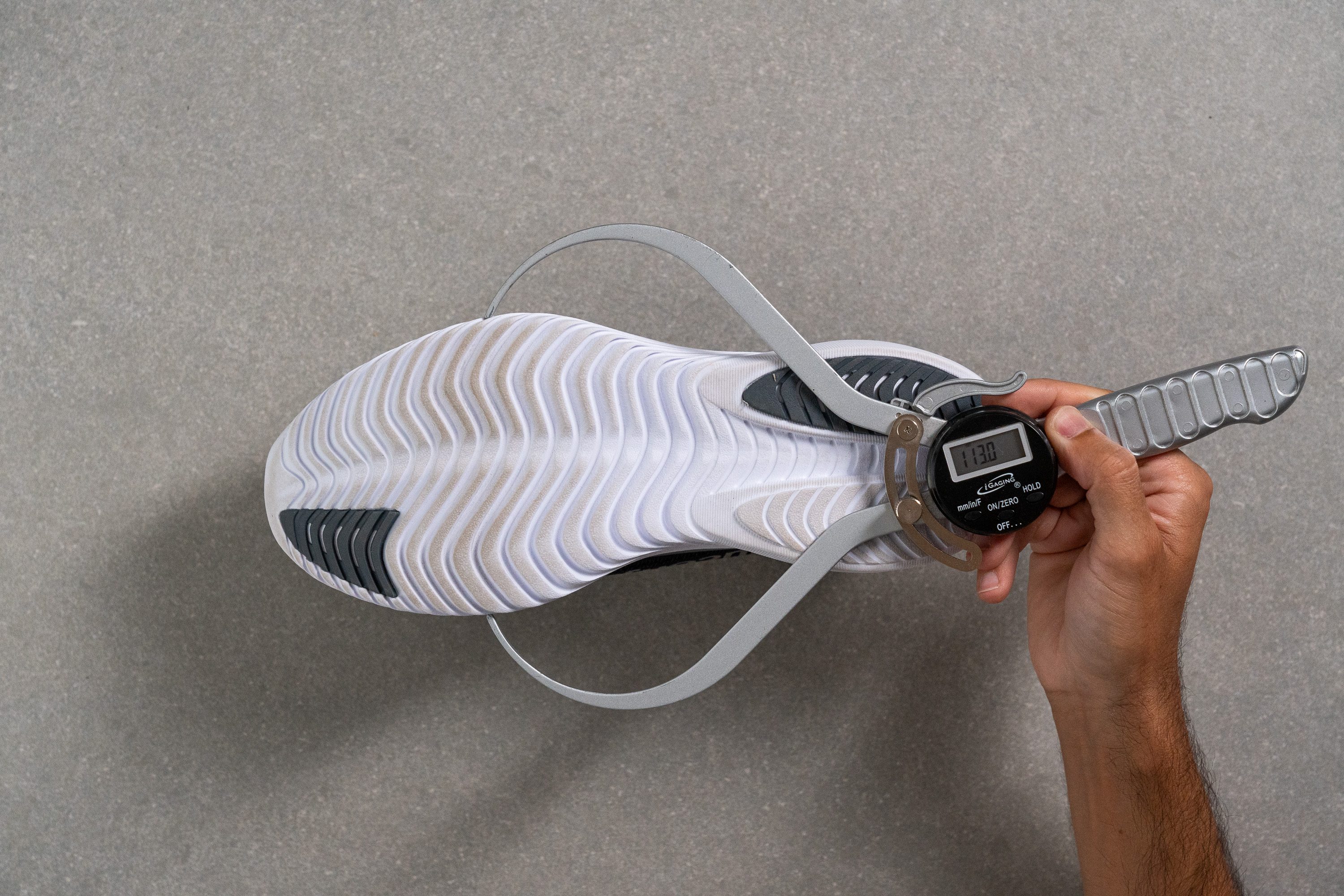
| Kinvara 15 | 113.0 mm |
| Media | 114.4 mm |
Anchura de la mediasuela - talón
La mediasuela de las Kinvara 15 se estrecha hasta los 88,9 mm en el talón, así que es un poco más finito de lo habitual, que es lo que les da a estas zapatillas una forma tan estilizada.

| Kinvara 15 | 88.9 mm |
| Media | 90.7 mm |
Durabilidad
Durabilidad de la parte delantera
La malla es muy transpirable, pero esto significa que su durabilidad es mínima.
Cuando le acercamos nuestro Dremel, no tardó nada en destrozarla, así que estas zapatillas terminaron con un agujero en la zona de los dedos. Esto hizo que solo pudieran llevarse un 1/5 en transpirabilidad.

| Kinvara 15 | 1 |
| Media | 2.6 |
Durabilidad del acolchado del talón
En nuestra evaluación del cuello del talón, vimos que está hecho de una tela más resistente diseñada para mejorar la durabilidad y reducir también la probabilidad de deslizamiento del talón.
Para saber incluso más sobre su durabilidad, hicimos una segunda prueba Dremel, y la verdad es que el forro del talón nos dejó alucinados. Casi no sufrió daños, lo que nos llevó a otorgarle una puntuación perfecta (5/5) en durabilidad.
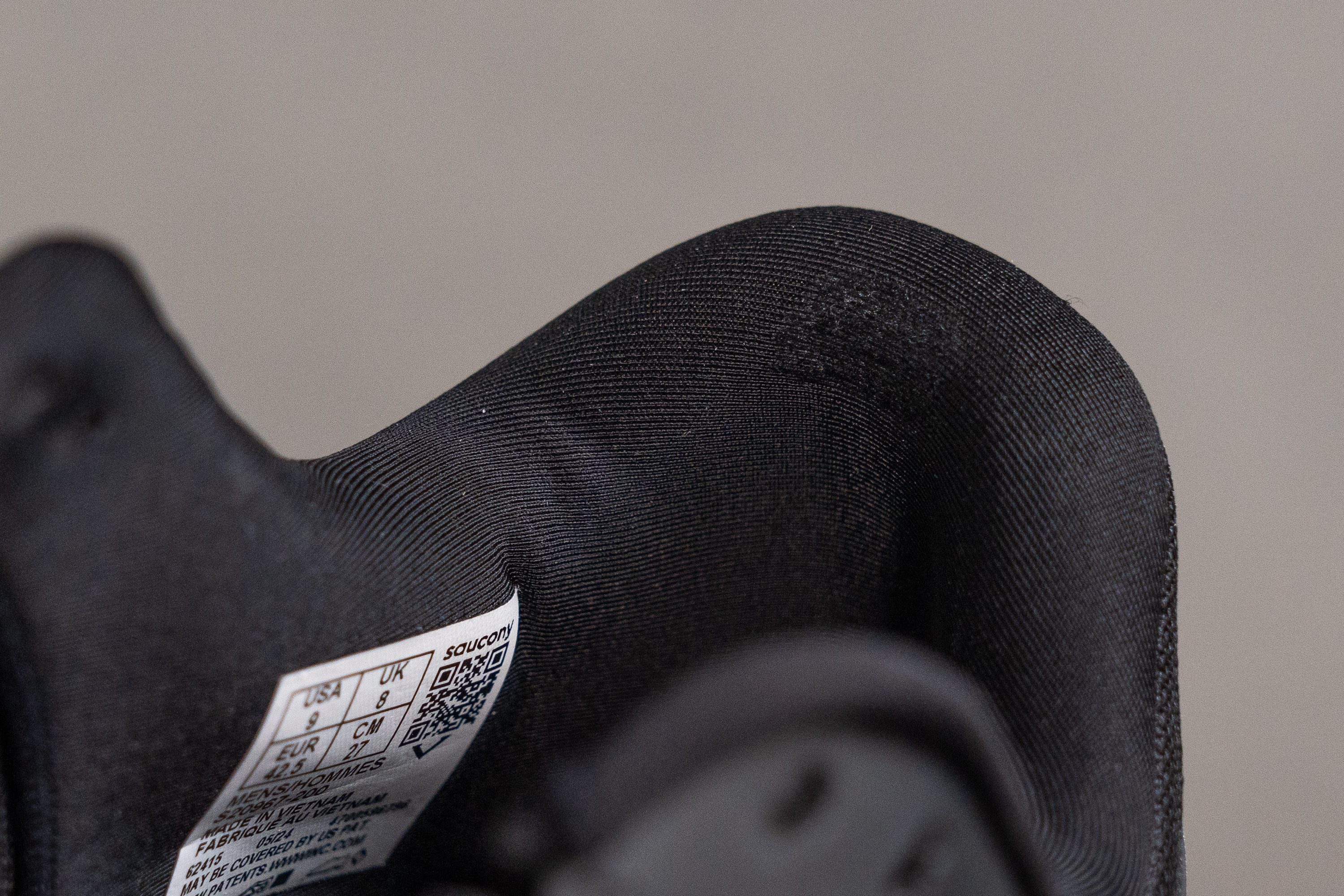
| Kinvara 15 | 5 |
| Media | 3.4 |
Dureza de la suela
Las Kinvara 15 tienen el mismo caucho que sus predecesoras, las Kinvara 14, y nuestras pruebas con el durómetro Shore C lo confirmaron, ya que marcó 79,1 HC.

Es un resultado medio en cuanto a dureza para una suela exterior, pero el compromiso de Saucony con la máxima ligereza implica el uso de una cobertura de caucho mínima, lo que nos hace preocuparnos un poco sobre la durabilidad.
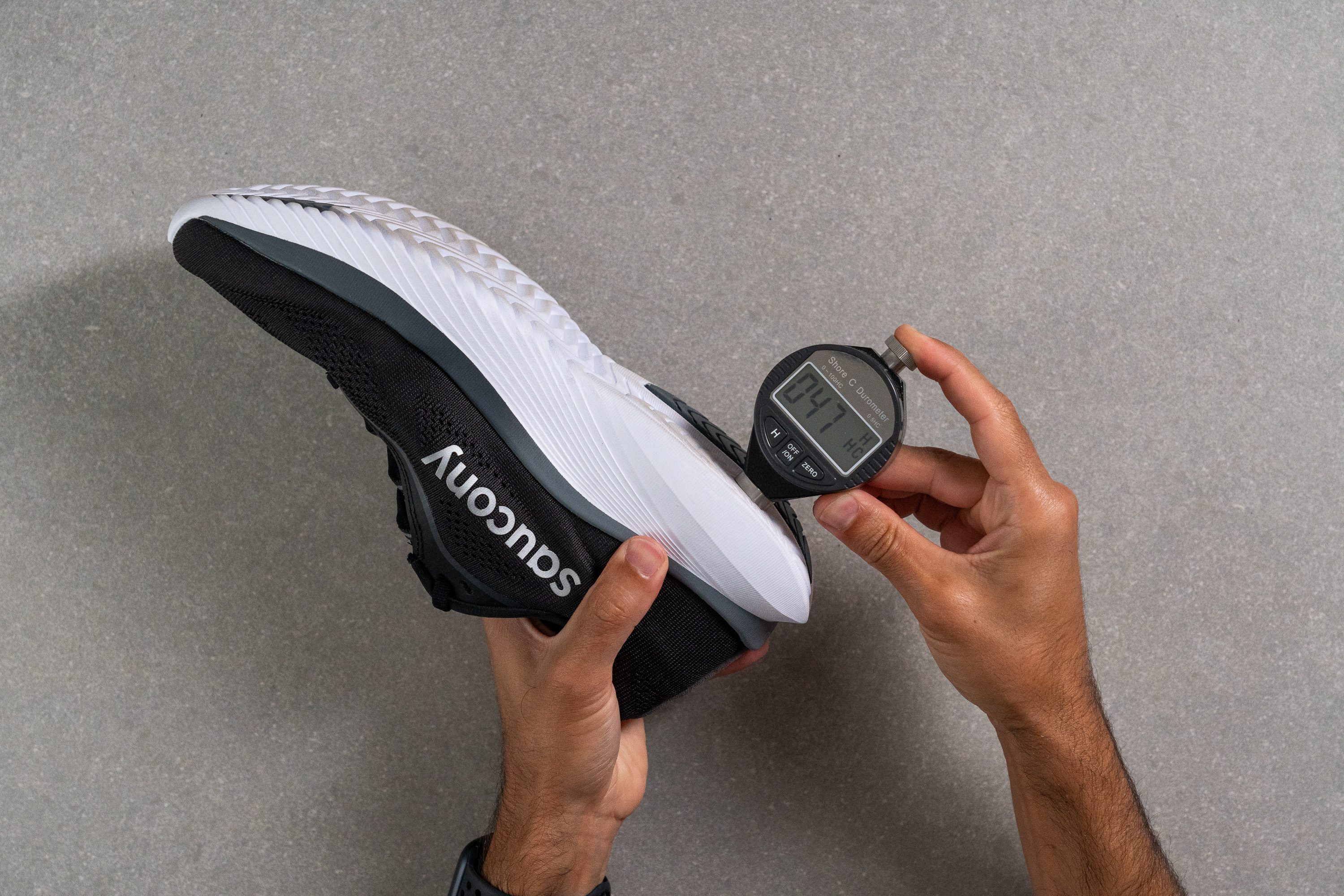
Como estas zapatillas tienen tanta mediasuela expuesta, decidimos analizar también esa EVA encauchada. Nuestro durómetro marcó 47,0 HC, un resultado que va de la mano con el de las suelas exteriores que hemos visto en zapatillas como las ASICS Cumulus 26. Por lo tanto, nos esperamos una durabilidad media-baja en general.
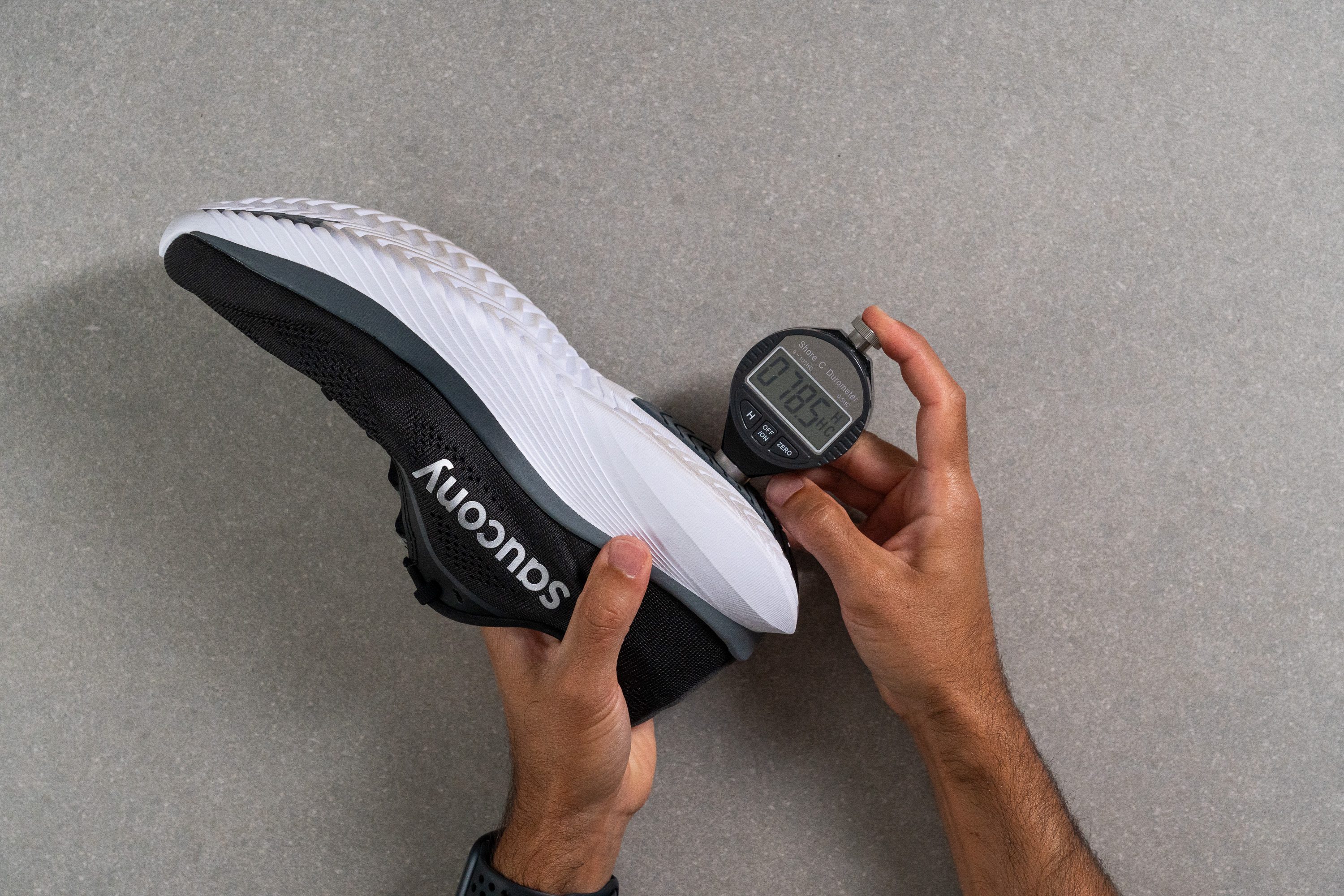
| Kinvara 15 | 79.1 HC |
| Media | 79.2 HC |
Durabilidad de la suela
Lo bueno es que el trocito de caucho que tienen en el talón aguantó bien nuestra última prueba Dremel, con unos daños de solo 0,9 mm.
Después de observar el diseño de la suela exterior, les recomendamos estas zapatillas a los corredores neutros. Los que tienden a caer con los lados del talón, pueden experimentar un rápido desgaste de la suela exterior, sobre todo los pronadores.
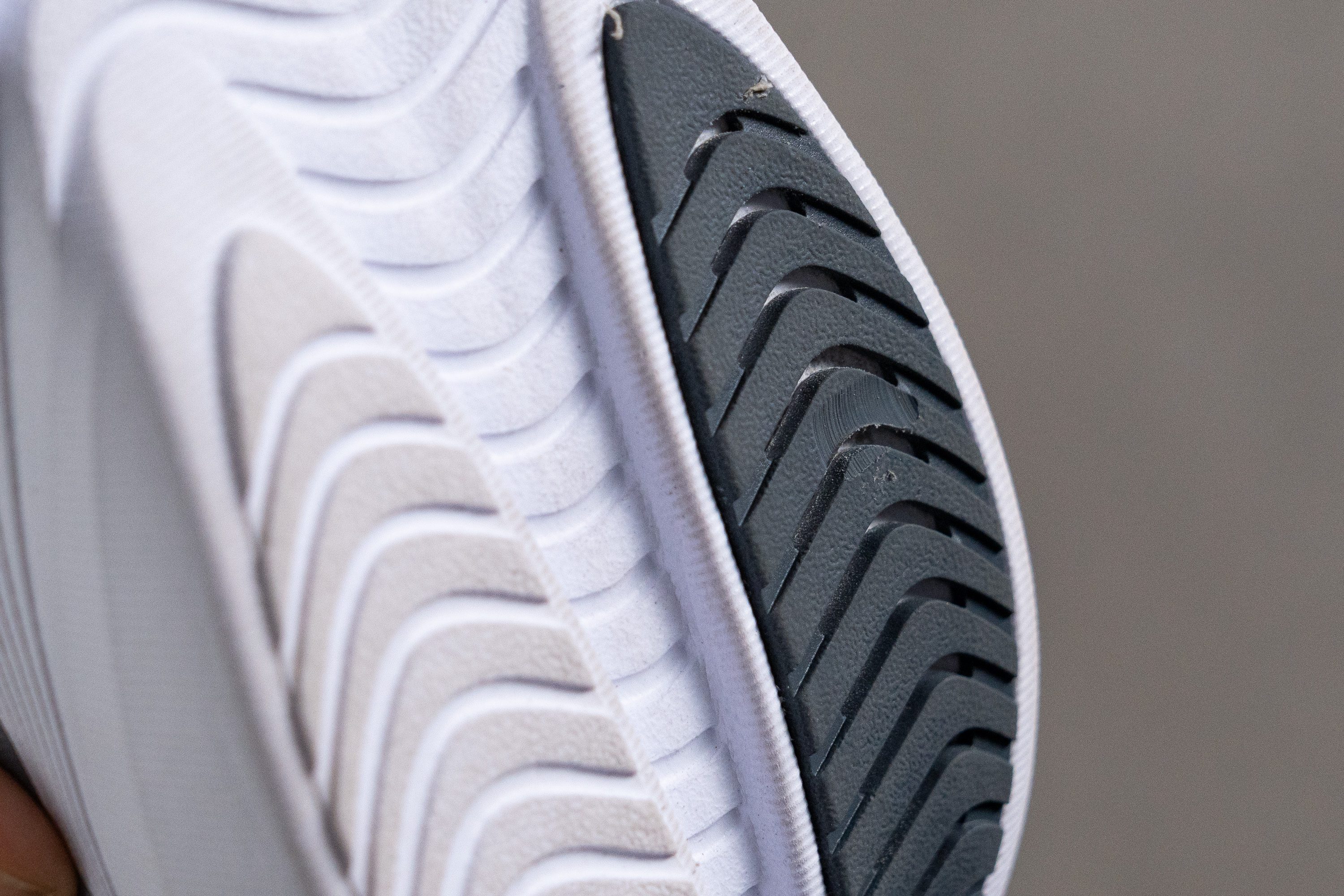
| Kinvara 15 | 0.9 mm |
| Media | 1.1 mm |
Grosor de la suela
Saucony decidió que el grosor de la suela exterior de este modelo fuese de 3,0 mm, lo que nos pilló totalmente desprevenidos. La verdad es que, con ese enfoque minimalista en cuando al diseño de la suela exterior y los 2,4 mm que nos dio esta misma medida cuando estudiamos a sus predecesoras, ¡nos esperábamos una capa incluso más fina!

| Kinvara 15 | 3.0 mm |
| Media | 3.2 mm |
Varios
Grosor de la plantilla
Al medirlo, nos dio 4,2 mm, siguiendo así la media que solemos ver en la mayoría de las zapatillas de running para asfalto.
Eso sí, esto tiene truco: la plantilla no está hecha de la típica EVA barata. En su lugar, está fabricada con espuma PWRRUN+, que ofrece una mayor reactividad que la mediasuela de las zapatillas.

| Kinvara 15 | 4.2 mm |
| Media | 4.5 mm |
Plantilla extraíble
Las Kinvara 15 vienen con una plantilla estándar de espuma PWRRUN+ que añade bastante rebote. Nuestra recomendación es no deshacerse de la plantilla, para así contar con su fantástico rendimiento, a menos que sea absolutamente necesario sustituirla.
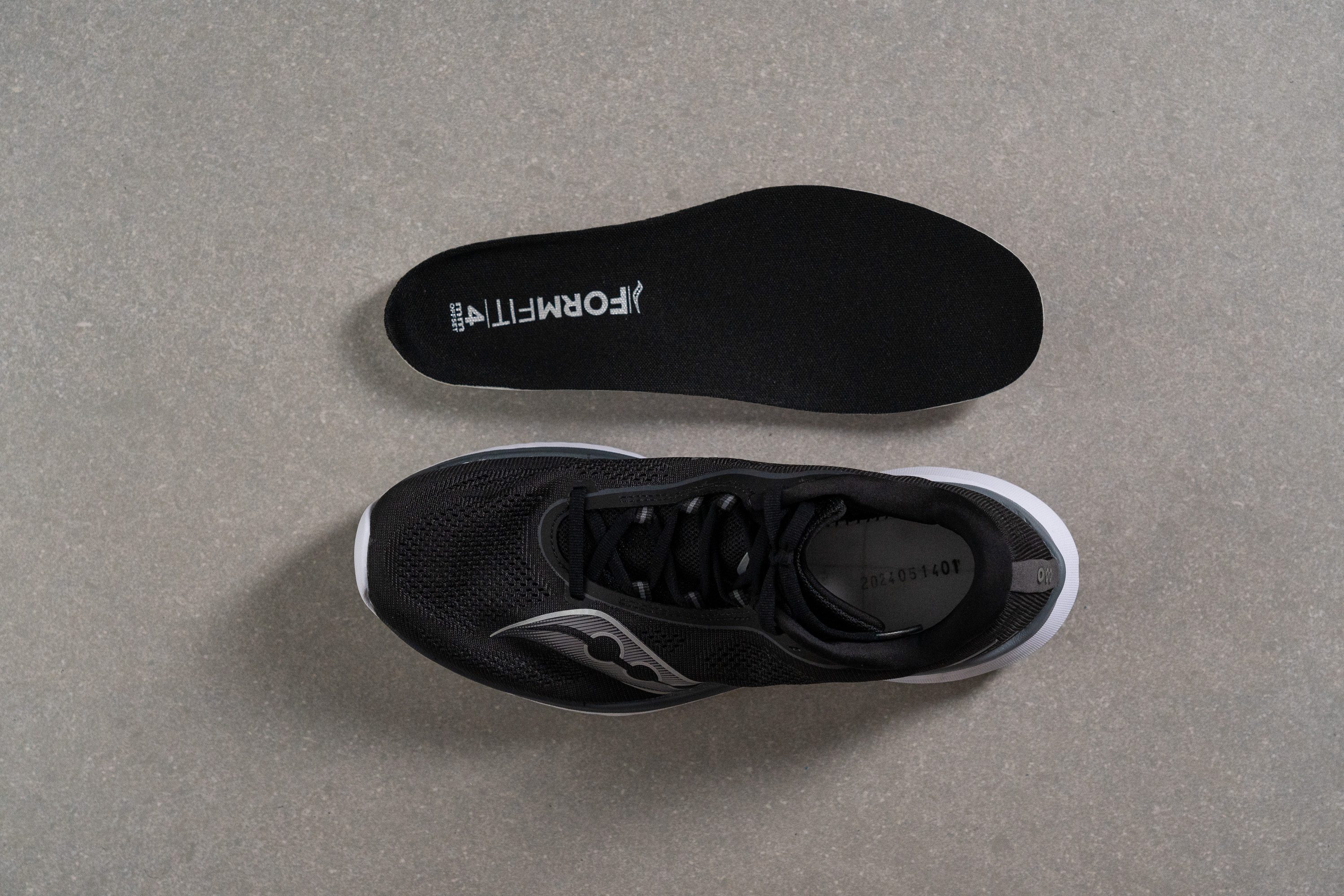
| Kinvara 15 | Sí |
Rigidez de la mediasuela en frío (%)
Mientras que las espumas de EVA suelen tener problemas con las bajas temperaturas, la PWRRUN (una mezcla de EVA y un poco de TPU, como hemos dicho antes), lo hizo muy bien en nuestra prueba de congelación, volviéndose solo un 18,9 % más firme.

| Kinvara 15 | 19% |
| Media | 24% |
Elementos reflectantes
Nos sorprendió gratamente encontrar elementos reflectantes en un modelo tan asequible. Aunque no son gigantescos, sí que proporcionan la visibilidad suficiente como para mejorar la seguridad por la noche cuando los coches se acercan por atrás.
| Kinvara 15 | Sí |
Acolchado de la lengüeta
Aunque la mediasuela y la suela exterior se parecen mucho a las de las Kinvara 14, la 15ª edición cuenta con una lengüeta mullida de 8,0 mm de grosor, más del doble que la de sus predecesoras.

Este cambio tiene sus pros y sus contras. Sí que es cierto que una lengüeta más gruesa mejora el ajuste, haciéndolo más cómodo. Pero como las Kinvara son conocidas por su diseño ligero, el volumen extra de la lengüeta nos parece contraproducente, sobre todo porque no están diseñadas como unas zapatillas para larga distancia, sino todo lo contrario.

| Kinvara 15 | 8.0 mm |
| Media | 5.8 mm |
Lengüeta: tipo de refuerzo
Desde un primero momento, ya tuvimos claro que las Kinvara 15 ofrecían una excelente relación calidad-precio, ¡pero cuando descubrimos que tienen una lengüeta semi-reforzada nos quedó incluso más claro!

| Kinvara 15 | Ambos lados (semi) |
Precio
Estas zapatillas de running también destacan por lo asequibles que son. Así que si estás buscando un par de running flexible y con una suela bajita, creemos que las Kinvara 15 son una de las mejores opciones si tenemos en cuenta su precio.
| Kinvara 15 | $120 |
Tirador del talón
Nos hemos dado cuenta de que estas zapatillas conservan algunos de los elementos de diseño de sus predecesoras. Al igual que el modelo anterior, esta versión tampoco tiene un tirador en el talón, manteniendo un diseño coherente.
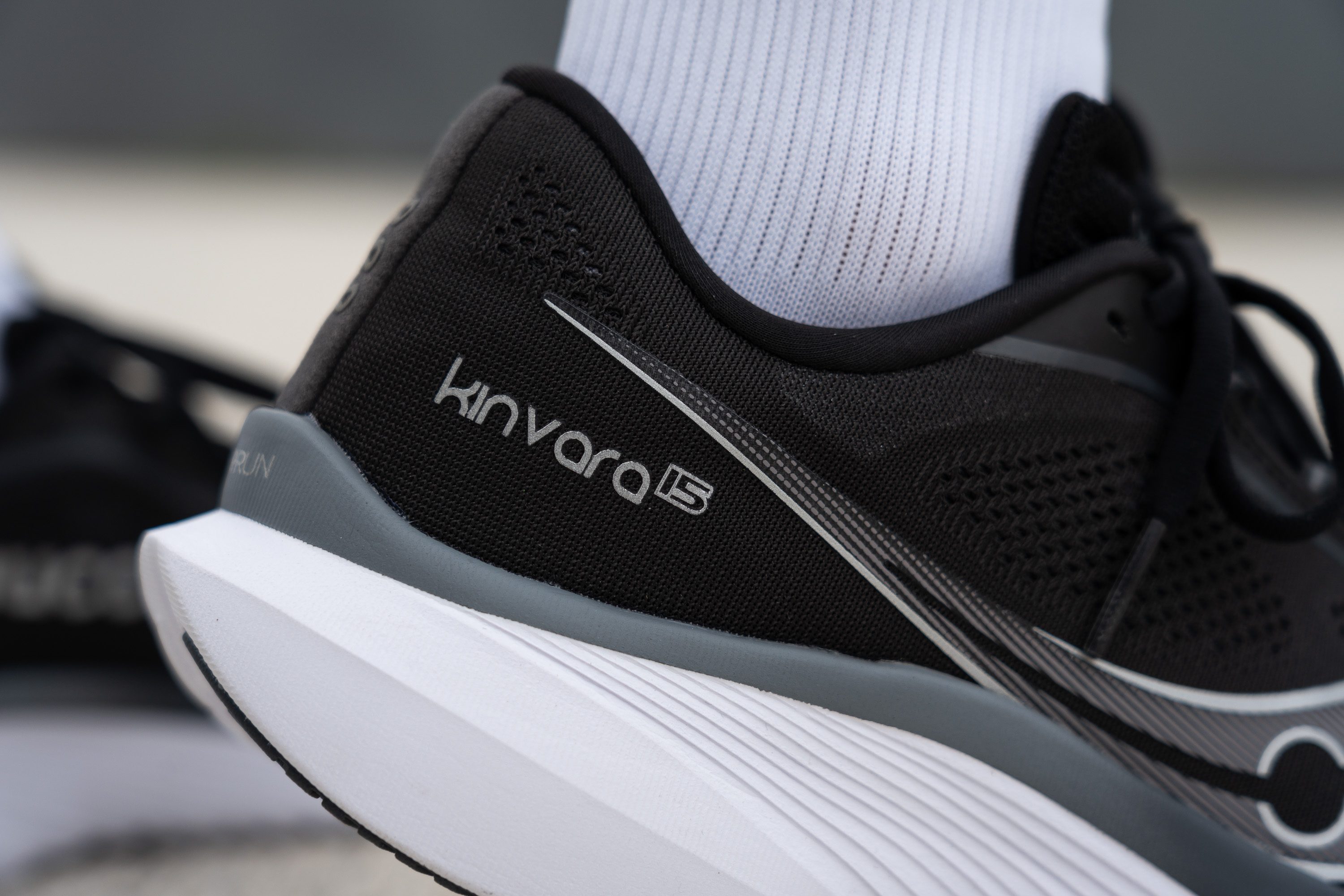
| Kinvara 15 | Ninguno |

